Private Forest Landowners are Making a Difference
with Road ImprovementsThe Forests & Fish Law requires that all state and private forest roads be brought up to new forest roads standards by 2021 through Road Maintenance and Abandonment Plans (RMAPs). The new standards address all aspects of construction and maintenance, including road locations, stream crossings, erosion control, and drainage. The goal is to minimize sediment in streams and remove barriers to fish passage. Prior to RMAP standards, landowners emphasized protecting the integrity of road systems from erosion by channeling road runoff into ditches, away from the road surface.
Forest landowners have taken a proactive approach to successfully surveying, repairing and planning work to protect natural streams and minimize the impact of forest roads. Starting in 2001, forest landowners took a "worst first" approach to surveying and repairing the thousands of miles of roads that run through forestlands and the results are impressive as illustrated by the map below:
From 2001 through 2021, forest landowners, including Green Diamond HCP have removed nearly 9,200 barriers to fish passage. Watch the red dots turn to green as road and culvert improvements are completed from 2001 - 2021. To date, 100% of the barriers identified have been eliminated, opening nearly 6,500 miles of historic fish habitat. This success has been achieved through investments by the state, small and large private landowners of $390 million—of which private forest landowners have contributed $265 million for road improvements through 2021.
Improving forested road systems

With forest landowners’ road improvements made to date, only 11% to 12% of roads have the potential to deliver sediment to the streams.
Large private forest landowners each develop a Road Maintenance & Abandonment Plan (RMAP) to upgrade and repair road systems where needed. A total of 53,000 miles of roads have been inventoried and 1,446 miles of roads identified as “needing improvement.” Based on the most recent data from the Department of Natural Resources’ RMAP Accomplishments Report. The RMAP program was completed as of October 21, 2021. In total, 3,992 miles of road have been decommissioned and 30,782 miles of road have been improved.
Small family forest landowners are required to submit checklists instead of a full Road Maintenance and Abandonment Plan (RMAP). Since 2003, family forest owners have submitted 18,804 RMAP checklists with their forest practices applications to identify how they will maintain and improve roads. Small forest landowners harvesting less than 2 million board feet of timber each year are eligible for the Family Forest Fish Passage Program, to fund replacement of eligible culverts or other barriers with new structures.
According to the Washington State Department of Natural Resources Compliance Monitoring Report, 98.8% of all road activities are compliant with forest practices regulations. WFPA members have a goal of being 100% compliant with all forest practices rules.
Landowner Spotlight: Road Abandonment and Stream Recovery
Today, forest landowners focus on protecting water quality for fish habitat by channeling road runoff onto the forest floor so that sediment will be filtered out before the water re-enters the stream. Port Blakely has successfully improved and updated the roads on their land. Port Blakely’s accomplishments are indicative of the ongoing improvements private forest landowners are making to minimize the impact of forested roads on the environment. Port Blakely discusses how they have implemented the new RMAP standards, and the difference it has made both economically and environmentally.
Rayonier is restoring salmon habitat to streams that haven't seen much life in the past century, as seen in the video above of one of the company's projects to open a stream bed in the forest near Hoquiam, Washington. Working with biologists and wildlife experts to bring salmon back into the upland streams in our Washington forests, Rayonier has invested millions of dollars to open more than 200 miles of stream habitat for salmon and other species that depend on them. Using the guidelines of the Forests & Fish Law, Rayonier enhances culverts and bridges and also closes or designs forest roads to prevent sedimentation. Click here to learn more.
Along with maintaining and improving forest roads that are in use, private forest land owners also restore inactive forest roads to a natural condition through the road abandonment program. The goal of road abandonment is to return inactive forest roads to the natural landscape so they do not require further maintenance by removing stream crossings and rebuilding the natural stream environment. Examples like Manulife's (former Hancock Timber Resource Group) efforts to remove 22,000 cubic yards of material from an old forest road along with rebuilding the natural stream bed at Red Creek in the White River Forest, show private forest landowners’ commitment to recover fish habitat and maintain clean water.
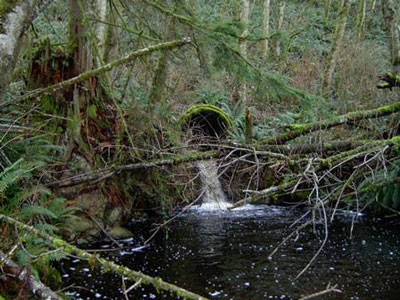
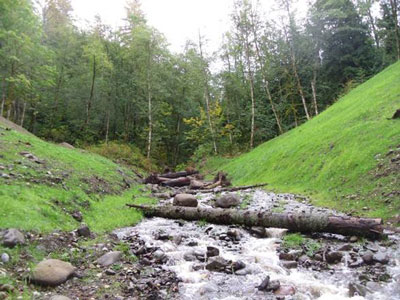
Protecting natural stream systems
One of the resource objectives of the Forests & Fish Law is to disconnect road drainage from streams in order to limit sediment being delivered to streams. Independent studies have found that, with the improvements made to date, only 11% to 12% of roads have the potential to deliver sediment to the streams. Forest landowners have improved forested roads in line with the Forests & Fish Law in order to provide storm water drainage systems to prevent surface runoff from delivering sediment to streams.
An example is the Adaptive Management Roads Sub-Basin Scale Effectiveness Monitoring Study (see page vi). The purpose of this research project is to determine if road characteristics that affect runoff and sediment delivery to streams are improving through time and the extent to which roads meet the identified performance targets. On average only 11% of the road network was hydrologically connected and assumed to deliver water and sediment to streams or wetlands.
Letting science lead the way: Reducing the impact of forest roads
A recent study (see page 1), designed and compiled by an environmental researcher, found that 82% of the entire length of forest industry roads have either a low delivery potential or are hydrologically disconnected from stream crossings.
The results of the study show that 73% of forest roads on industrial lands have a low potential to deliver runoff and sediment to streams because the roads occur on flat terrain such as valley bottoms or ridge tops that do not intersect stream channels or drain into a wetlands. Of the remaining 27%, 6% are unused, overgrown or decommissioned roads.
Of the 21% of road length that could potentially threaten streams, improvements have been made by landowners to fix about half (9%), leaving only about 12% of the roads hydrologically connected to streams at the time of this survey. The remaining roads are in process of being fixed through the RMAP program, with a completion date in the Forests & Fish Law of 2021.
Removing barriers to fish passage
From 2001 through 2021, state and private landowners have invested $390 million in forest road improvements.
In addition to minimizing sediment delivery to streams, small and large private forest landowners are removing barriers to fish passage. From 2001 through December 2021, landowners have removed nearly 9,200 barriers, restoring nearly 6,500 miles of historic fish habitat. This is about 100% of the way to the goal of completion by October 2021.
From 2001 through 2021, large state and private landowners have invested $340 million in forest road improvements. The result is the removal or repair of 8,749 barriers to fish migration, which restored 5,347 miles of historic fish habitat.
The Family Forest Fish Passage Program (FFFPP), a Washington State cost-share program for small family forest owners, have invested $49.7 million in the repair of 433 barriers resulting in 1,149 miles of reconnected habitat, bringing the total to 9,182 barriers removed and the restoration of 6,486 miles of historic fish habitat.
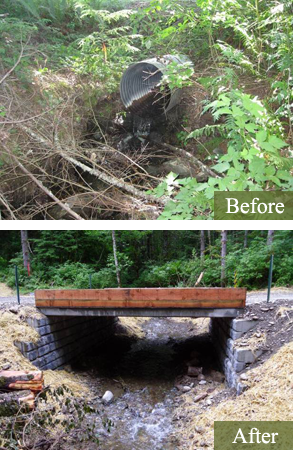
Landowner Spotlight: Innovations in Road Building Materials and Technique
Recent innovations in road building materials and techniques have allowed fish habitat to be recovered, while maintaining important forest roads. By using sturdier road building materials, private forest landowners are able to create less intrusive structures over streams and other potential fish passage barriers. In some instances (like this example below from Manulife (formerly Hancock)), new techniques allow private forest landowners to remove conventional culverts and replace them with small bridges or eco-puncheons.
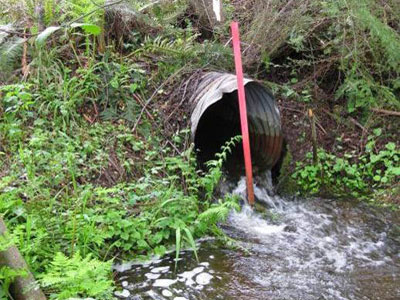
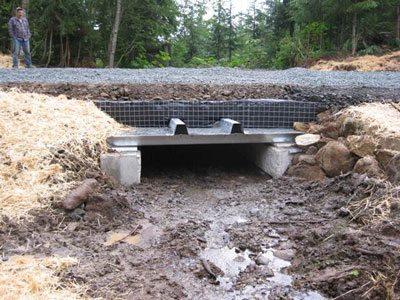
Letting science lead the way: New culvert designs aid in fish passage
Researchers are testing mock up culvert installations for their fish friendly design in this Culvert Test Bed study. Fisheries biologist Phil Peterson measures how well cutthroat trout move through culverts under various flow conditions. The research was commissioned by forest landowners from Oregon and Washington and is using a facility owned by the Washington Department of Transportation.
Scientists and forest landowners use these results to help determine whether culverts installed in their road systems best allow fish to gain access to their natural freshwater habitat in forested streams.